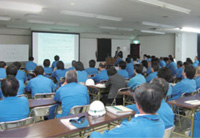Home > About Fuji Electric > CSR > Environmental Report > Reducing Environmental Impact through Fuji Electric Products
Reducing Environmental Impact through Fuji Electric Products
Fuji Electric works to develop and promote the widespread adoption of eco-products, which boost energy efficiency, cut chemical substances contained in products and take various other environmental factors into account. We also develop and promote products that help to alleviate the environmental burden of society as a whole.
Eco-Product Certification Regulations
Fuji Electric evaluates the degree of product environmental contribution and environmental friendliness on a groupwide platform. Products meeting fixed environmental-friendliness criteria are certified as "eco-products," while those that are at the top of the industry for environmental benefit and contribution, or which are recognized outside the company at the national level for environmental superiority are labeled "super eco-products."
Our environmental medium-term plan for the three years through FY2011 includes expanding the proportion of eco-products in the Fuji Electric portfolio to 40%.

Quantitative Assessment of Product Environmental Contributions
Fuji Electric's Environmental Vision 2020 cites a target of reducing societal CO2 emissions 2.4 million tons by 2020 through the provision of energy-saving and energy-creating products. Our goal also includes bringing the overall sales ratio of eco-products to 70% by the same year.
During FY2009, we classified products that can help reduce CO2 emissions into four groups and devised quantitative CO2 reduction calculation methods.
Our targets for FY2010 were "30% of total net sales comprised of eco-products" and "CO2 emissions volume reduction of 850,000 tons." We achieved both targets, with reductions of 32.1% and 1.11 million tons, respectively.
For FY2011, we have set an eco-products sales ratio target of 40% and a CO2 emissions volume reduction target of 1 million tons, as we continue working to create eco-products and increase the CO2 reduction effect.
Example of a CO2 Reduction Effect Calculation
By realizing 98.5% efficiency for our UPS8000ND Series of uninterruptible power supply systems (UPSs), we have achieved a CO2 reduction benefit of 93 tons per year compared with previous models.
Comparison of CO2 Emission Volumes

- Operating conditions:
8,760 hours operation per year; load factor of 80% - Conventional model:
6000D
Regular inverter supply
Launched in FY2003, 92% efficiency - Current model:
8000ND series (500KVA)
Dial processing
Launched in FY2011, 98.5% efficiency - Energy charge:
¥13.9/kWh - CO2 emission coefficient:
0.41kg-CO2/kWh

Optimal Control Systems of Chemical Substances Contained in Products

Fuji Electric conforms to all laws and regulations on chemical substances contained in products in regions where we operate, worldwide. To achieve this, we promote the sharing of information on legislative trends and other issues through regular (roughly every three months) liaison meetings and annual companywide seminars. We also conduct chemical substance risk assessments that take into consideration materials used in our products and manufacturing processes, so as to build optimal control systems for each operating site.
During FY2010, we organized regular liaison meetings to share the latest information concerning environmental regulations from regions worldwide, such as the European Union and China, for a more thorough response. We also conducted energy and environment-themed companywide seminars, with 135 participants.
Furthermore, we continued last year's efforts to conduct explanatory briefings on the universal database we constructed for chemical substance control in response to the REACH* Regulations. These were held at 19 locations, with a total of 440 participants.
We will continue to fulfill our duties as member of the supply chain by gathering information pertaining to chemicals contained in procurement items and providing it to customers.
* REACH Regulation: A comprehensive regulation concerning the registration, evaluation, authorization and restriction of chemicals that calls for information management in the supply chain as well as companies that manufacture products.

-
- Corporate Profile
- CSR
- Management Structure
- Social Report
- Environmental Report
- Topic 1/Reducing Environmental Impact through Our Products
- Topic 2/Reducing Environmental Impact at Our Production Bases
- Environmental Management
- Environmental Management Targets and Results
- Interplay between Business Activities and Environmental Impact
- Preventing Global Warming
- Recycling of Resources
- Management of Chemical Substances
- Preservation of Biodiversity
- Reducing Environmental Impact through Fuji Electric Products
- Together with Local Communities
- Research & Development

